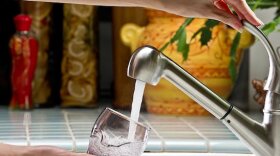In late April, we launched a series called “Contaminated” where our team explores communities in the region affected by water unsafe to drink. In our first story, we visited a Fresno County community that can’t afford to maintain the arsenic treatment plant the federal government funded 10 years ago.
"For the first time . . . ever, they will have water that meets all of the drinking water standards, which from a public health perspective is very encouraging."- Kassy Chauhan
We continue today with a look at a Madera County mountain community where residents have been exposed to a different hazardous material in water for decades—but they could have clean water by the end of the year.
When Debbie Acree and her husband moved to the city of Oakhurst 17 years ago, they were told the water may not be safe to drink. They weren’t too worried—until: “The first morning, we get up and make a cup of coffee,” says Acree. “My husband puts creamer in it and it actually curdled. We were like, ‘Oh my God, we’ve got to go buy water.’”
Since then, they’ve stocked up on $50-worth of bottled water every month. The water in Oakhurst has many problems, but plumber Rick Markley has given one of the biggest ones a nickname.
“We call that vitamin u,” Markley says, because everyone drinks it. “You don’t even have any choice.”
“Vitamin U” means uranium. It’s in the tap water here. Oakhurst is one of nearly 300 California communities with drinking water issues revealed earlier this year by the state’s new Human Right to Water portal. Uranium is a problem for many water districts in the valley, but it’s a particular challenge in mountain communities, many of which struggle with other contaminants as well.
Out of all the non-compliant water systems in the state, a handful in the Madera County foothills have tested the highest for uranium. But they’ve also got a solution right around the corner.
So what is uranium, and how did it get here? It’s a radioactive metal on the periodic table, and it forms naturally in rocks. According to Mike Massey, an environmental scientist at CSU East Bay, uranium’s probably a lot more abundant than you might think.
"Uranium-238 is not what they make bombs out of. Uranium-238 is what they throw away so they can keep the [uranium-]235 and make bombs out of that." - Mike Massey
“It’s common in the crust,” Massey says. “You probably have uranium in the soil in your yard. It’s even slightly more common in granite, like you find in California in the Sierras.”
In fact, uranium’s about as abundant as another metal that’s commonly in the news: arsenic. They both leach into groundwater through entirely natural processes.
So when you hear uranium, you may think nuclear bombs, or Homer Simpson fumbling with glowing green rods at the power plant. But the kind of uranium pestering the foothills is nothing that sinister. Massey says that’s because uranium can occur as different isotopes—forms that have different masses and levels of radioactivity. Over 99 percent of the uranium out there is the isotope uranium-238.
“Uranium-238 is not what they make bombs out of,” Massey says. “Uranium-238 is what they throw away so they can keep the [uranium-]235 and make bombs out of that.”
Uranium-238 is far less radioactive than its sister isotopes. So, in Oakhurst, water officials say it’s totally safe to shower and wash your clothes with the water. Drinking it over the long-term, however, is associated with cancer and organ failure.

"All of this facility will be taken out. It'll be re-graded and leveled and a whole new treatment plant will be here." - Jim Foster
Cleaning up uranium can be challenging and expensive. Kevin Berryhill is an engineer with the environmental consulting group Provost and Pritchard. With high uranium levels, he says, the best option is to spend a few hundred bucks on a filter that fits under the sink.
“And that’s important: it needs to be an under-sink unit with reverse osmosis,” Berryhill says, “because just a regular Brita, which is an activated carbon filter, will not necessarily take out any of the uranium.”
But in Oakhurst, where thousands of residents rely on the water, providers are thinking bigger. They’ve turned to a water treatment plant that currently takes care of other contaminants.
“This is the site of our current iron manganese removal system,” says Jim Foster, gesturing to four large tanks on a plot of land south of Oakhurst. He’s the general manager of Hillview Water Company, which provides water to most of Oakhurst and the surrounding area.
At the moment, uranium in the town’s source wells tests at almost three times what the state says is acceptable to drink. But, at the treatment plant, Foster says they mix that contaminated water with clean water, so what reaches homes is far cleaner. Even so, it’s out of compliance with state standards.
According to Foster, that will all change in the near future when a new treatment plant is erected in this very spot. “All of this facility will be taken out,” he says. “It’ll be re-graded and leveled and a whole new treatment plant will be here.”
The new plant will use a more involved filtration system to remove uranium, as well as arsenic, iron and manganese from the water. Plus, Foster says whatever is removed out will be recycled rather than being dumped in a toxic waste landfill.

“It doesn’t end up stored someplace to where you would have to worry about it leaking out,” Foster says, “or someone calling you in 50 years saying well there’s a barrel marked with your company on it so you have to participate in the cleanup of it.”
Foster says the state funded treatment facility needs to be built within the next two years and will cost around $5 million. It’ll serve around 4,000 people in Oakhurst. Planning is also underway for three other water treatment plants in smaller communities nearby.
Even though water rates will rise slightly to maintain the project, Kassy Chauhan with the State Water Resources Control Board says the facility is running will be a huge benefit for the town.
“For the first time in, for most people, ever, they will have water that meets all of the drinking water standards, which from a public health perspective is very encouraging,” Chauhan says.
The system will eventually extend to some private well owners as well a high school. Construction should begin in early June and the uranium treatment portion could be up and running by the end of year.








